Themed collection Plastic Waste Utilisation: A cross-journal collection

From plastic waste to new materials for energy storage
A perspective on using plastic waste as an alternative feedstock for the energy storage sector through upcycling. Materials for electrodes, electrolytes or binders could be obtained from both advanced combustion and depolymerization methods.
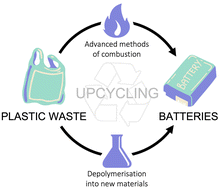
Polym. Chem., 2022,13, 4222-4229
https://doi.org/10.1039/D2PY00592A
Recent development of end-of-life strategies for plastic in industry and academia: bridging their gap for future deployment
Bridging the gap between academia and industry in plastic recycling will accelerate innovation and deployment toward solving the global challenge of plastic waste management and establishing net zero carbon society.
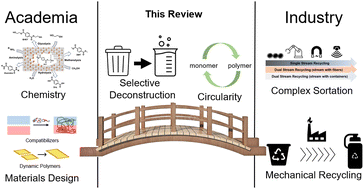
Mater. Horiz., 2023,10, 1608-1624
https://doi.org/10.1039/D2MH01549H
A systematic review on plastic waste conversion for a circular economy: recent trends and emerging technologies
Our biosphere has been adversely affected by plastic waste pollution, especially non-biodegradables in landfills, which induces hazardous chemical leaching and toxic gas emissions on burning into the atmosphere.

Catal. Sci. Technol., 2023,13, 2291-2302
https://doi.org/10.1039/D2CY02066A
Improving plastic pyrolysis oil quality via an electrochemical process for polymer recycling: a review
In this review we discuss the application of electrochemical hydrogenation for pyrolysis oil upgrading, thus facilitating a circular polymer economy and low-carbon fuel production.

Energy Adv., 2024,3, 366-388
https://doi.org/10.1039/D3YA00389B
Recycling and the end of life assessment of fluoropolymers: recent developments, challenges and future trends
Herein, we present the state of the art technology on the recycling, reuse, thermal decomposition, and the life cycle assessment of fluoropolymers (FPs, ranging from PTFE and PVDF to various fluorinated copolymers based on VDF and TFE).

Chem. Soc. Rev., 2023,52, 4208-4247
https://doi.org/10.1039/D2CS00763K
Recent advances in plastic recycling and upgrading under mild conditions
This review summarizes the emerging advanced technologies including bio-, photo-, electro-, and low-temperature thermocatalysis for recycling and upgrading of waste plastics under mild conditions.

Green Chem., 2023,25, 6949-6970
https://doi.org/10.1039/D3GC01872E
Electrocatalytic upcycling of plastic waste
The electrochemical upcycling of plastic waste offers a more efficient and safer means to produce value-added products under mild conditions.

Green Chem., 2023,25, 8444-8458
https://doi.org/10.1039/D3GC03337F
Waste plastic to energy storage materials: a state-of-the-art review
Waste plastics can be recycled for use in energy storage materials (e.g., electricity, heat storage, and hydrogen). The study aims to provide a basis for further research on the integrated use of waste plastics while reducing carbon emissions.

Green Chem., 2023,25, 3738-3766
https://doi.org/10.1039/D2GC04927A
Techno-economic analysis and life cycle assessment for catalytic fast pyrolysis of mixed plastic waste
This study analyzes catalytic fast pyrolysis as a conversion technology for mixed plastic waste, highlighting key economic and environmental drivers and potential opportunities for process improvements.

Energy Environ. Sci., 2023,16, 3638-3653
https://doi.org/10.1039/D3EE00749A
Upcycling rust and plastic waste into an Fe MOF for effective energy storage applications: transformation of trash to treasure
An Fe-based metal–organic framework is synthesized utilizing metal sourced from iron rust and a linker sourced from PET bottle waste. Further, the MOF is deployed as the active electrode material for a supercapacitor.

Dalton Trans., 2023,52, 8204-8210
https://doi.org/10.1039/D3DT01436C
From waste plastics to layered porous nitrogen-doped carbon materials with excellent HER performance
Layered porous nitrogen-doped carbon sheets prepared from waste plastics are employed as an excellent HER catalyst under alkaline conditions.

Chem. Commun., 2023,59, 6187-6190
https://doi.org/10.1039/D3CC01348K
Selective poly(vinyl ether) upcycling via photooxidative degradation with visible light
Selective chemical upcycling of poly(isobutyl vinyl ether) was achieved using photooxidative degradation, producing oxidized small molecules that can be tuned depending on a choice of photocatalysts.

Chem. Sci., 2024,15, 1840-1845
https://doi.org/10.1039/D3SC05613A
Enhancing the photocatalytic upcycling of polystyrene to benzoic acid: a combined computational-experimental approach for acridinium catalyst design
Computational-assisted catalyst design facilitates identification of a potent non-intuitive fluorinated acridinium catalyst for aerobic photoredox conversion of polystyrene to benzoic acid.

Chem. Sci., 2024,15, 1061-1067
https://doi.org/10.1039/D3SC06388G
Conformations of polyolefins on platinum catalysts control product distribution in plastics recycling
The design of catalysts for the chemical recycling of plastic waste will benefit greatly from an intimate knowledge of the interfacial polymer–catalyst interactions that determine reactant and product distributions.
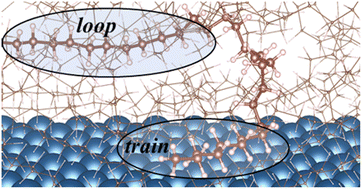
Chem. Sci., 2023,14, 1966-1977
https://doi.org/10.1039/D2SC04772A
Catalytic fabrication of graphene, carbon spheres, and carbon nanotubes from plastic waste
In this investigation, we reported sustainable and economical upcycling methods for utilizing plastics as cheap precursors for the production of high-value carbon materials such as graphene (G), carbon spheres (CS), and carbon nanotubes (CNTs).

RSC Adv., 2024,14, 1977-1983
https://doi.org/10.1039/D3RA07370J
From wasted polymers to N/O co-doped partially graphitic carbon with hierarchical porous architecture as a promising cathode for high performance Zn-ion hybrid supercapacitors
N/O co-doped graphitic hierarchical porous carbon is yielded from wasted polymers. A capacity of 257.9 mA h g−1 with an ultrahigh energy density of 226.5 W h kg−1 is delivered. Excellent energy storage ability is also obtained for wearable devices.

J. Mater. Chem. A, 2024,12, 1012-1025
https://doi.org/10.1039/D3TA06393C
From waste to energy storage: post-consumer waste expanded polystyrene/rGO composite as a high performance self-standing electrode for coin cell supercapacitors
Free-standing electrodes prepared from waste expanded polystyrene by incorporating rGO into it for supercapacitor applications.

RSC Adv., 2024,14, 689-699
https://doi.org/10.1039/D3RA07071A
Quantifying synergy for mixed end-scission and random-scission catalysts in polymer upcycling
Given sufficient end-scission catalyst, random scission causes a proliferation of new chain ends and thereby accelerates the overall depolymerization progress.

React. Chem. Eng., 2024,9, 139-147
https://doi.org/10.1039/D3RE00390F
Hybrid thermo-electrochemical conversion of plastic wastes commingled with marine biomass to value-added products using renewable energy
Surface plastics and microplastics commingled with biomass are emerging pollutants in the marine environment.

Energy Environ. Sci., 2023,16, 5805-5821
https://doi.org/10.1039/D3EE02461J
An efficient and recyclable Ni2P–Co2P/ZrO2/C nanofiber photocatalyst for the conversion of plastic waste into H2 and valuable chemicals
Transformation of PET waste using a Ni2P–Co2P/ZrO2/C NF photocatalyst in aqueous medium.

J. Mater. Chem. C, 2023,11, 14359-14370
https://doi.org/10.1039/D3TC02702C
Upcycling of plastic waste into carbon nanotubes as efficient battery additives
Carbon nanotubes (CNTs) were produced from waste face mask and non-recyclable mixed plastic waste via pyrolysis-chemical vapor deposition (CVD).
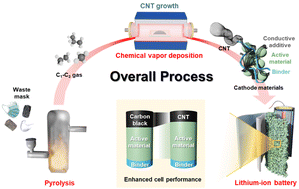
Green Chem., 2023,25, 8007-8018
https://doi.org/10.1039/D3GC02100A
Delivering low-energy carbon capture with photo-responsive hypercrosslinked polymers derived from polystyrene waste
Exploiting photo-isomerisation of azobenzene molecules embedded in pores of hypercrosslinked polymers to drive adsorption (upon UV light irradiation) and desorption (visible light irradiation) of CO2 to enable low-energy, low-cost carbon capture.

J. Mater. Chem. A, 2023,11, 20559-20567
https://doi.org/10.1039/D3TA04553F
Conversion of low-density polyethylene plastic waste into valuable fuels using fly ash as a catalyst
Waste low-density polyethylene (LDPE) plastic was pyrolyzed using a batch reactor fuel oil fly ash catalyst into valuable fuels using fly ash as a catalyst.

Sustainable Energy Fuels, 2023,7, 4935-4954
https://doi.org/10.1039/D3SE00779K
Metal-free photocatalytic transformation of waste polystyrene into valuable chemicals: advancing sustainability through circular economy
Upcycling waste polystyrene into valuable chemicals acetophenone and benzoic acid is developed through an innovative and environmentally-friendly photocatalytic process involving a metal-free carbon catalyst.

Green Chem., 2023,25, 7318-7334
https://doi.org/10.1039/D3GC02591H
Electrocatalytic valorization of waste polyethylene furanoate (PEF) bioplastics for the production of formic acid and hydrogen energy
Recovery of PEF by oxidation of EG with non-precious metal catalysts to obtain formic acid and hydrogen at a cathode is an important strategy for achieving sustainable development.

React. Chem. Eng., 2023,8, 1937-1942
https://doi.org/10.1039/D3RE00028A
Dispersion of PM and VOC pollutants from open burning of municipal solid wastes on host communities: emission inventory estimation and dispersion modelling study
This study focused on the dispersion of PM and VOC pollutants from the open burning of solid waste on the Sokoto-Aiyekale dump site in Ilorin, Nigeria, owing to the scarcity of information on pollutants' impact on onsite workers and the population surrounding the dump site.

Environ. Sci.: Atmos., 2023,3, 1090-1109
https://doi.org/10.1039/D3EA00041A
Nonviable carbon neutrality with plastic waste-to-energy
Energy recovery of plastic waste without carbon capture resulted in higher CO2 emissions than from fossil fuels. Potential electricity generation in 2050 from plastic waste-to-energy could be significantly increased.
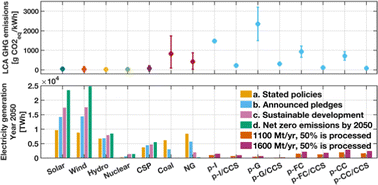
Energy Environ. Sci., 2023,16, 3074-3087
https://doi.org/10.1039/D3EE00969F
Techno-economic analysis and life cycle assessment of mixed plastic waste gasification for production of methanol and hydrogen
This work examines the feasibility of a greenfield mixed plastics waste gasification facility with process modeling, TEA, and LCA.

Green Chem., 2023,25, 5068-5085
https://doi.org/10.1039/D3GC00679D
High-purity polypropylene from disposable face masks via solvent-targeted recovery and precipitation
The high-purity polypropylene could be produced from the waste disposable face masks via an efficient solvent-targeted recovery and precipitation (STRAP) method, combined with a simple decolorization step.
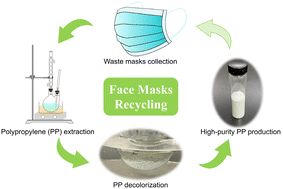
Green Chem., 2023,25, 4723-4734
https://doi.org/10.1039/D3GC00205E
Large-scale computational polymer solubility predictions and applications to dissolution-based plastic recycling
We demonstrate a joint computational and experimental approach to predict polymer solubilities at a large scale. This approach can facilitate solvent screening and process design for dissolution-based plastic recycling processes.

Green Chem., 2023,25, 4402-4414
https://doi.org/10.1039/D3GC00404J
Visible light driven reform of wasted plastics to generate green hydrogen over mesoporous ZnIn2S4
A mesoporous ZnIn2S4 photocatalyst shows notable activity for photoreforming of PLA, PET and PU to generate small organic chemicals and H2 fuel under simulated sunlight at room temperature.

RSC Adv., 2023,13, 12663-12669
https://doi.org/10.1039/D3RA02279J
Upcycling waste expanded polystyrene into UV-excited dual-mode multicolor luminescent electrospun fiber membranes for advanced anti-counterfeiting
A simple and effective method to upcycle waste EPS to UV-excited dual-mode multicolor luminescent membranes for advanced anti-counterfeiting was developed.

RSC Adv., 2023,13, 10123-10134
https://doi.org/10.1039/D3RA00509G
Performance of a membrane fabricated from high-density polyethylene waste for dye separation in water
Industrial growth can have a good impact on a country's economic growth, but it can also cause environmental problems, including water pollution.

RSC Adv., 2023,13, 7789-7797
https://doi.org/10.1039/D2RA07595D
Plastic waste generation and emissions from the domestic open burning of plastic waste in Guatemala
Domestic, or household-level, open burning of plastic waste is a substantial source of air pollutants and greenhouse gases that are often neglected in Guatemala.

Environ. Sci.: Atmos., 2023,3, 156-167
https://doi.org/10.1039/D2EA00082B
Supramolecularly cross-linked nanoassemblies of self-immolative polyurethane from recycled plastic waste: high encapsulation stability and the triggered release of guest molecules
Recycled plastic waste based self-immolative polyurethane has been synthesized and nanoformulated for tumor relevant pH induced charge modulation, efficient guest encapsulation and triggered release in a controlled fashion.
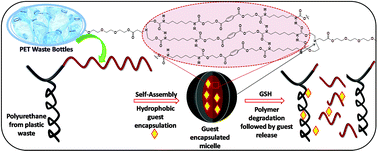
Polym. Chem., 2022,13, 3294-3303
https://doi.org/10.1039/D2PY00341D
About this collection
According to UN reports, the world is producing 430 million tonnes of plastic per year, with plastic pollution set to triple by 2060 if no action is taken.
To counter this, along with a reduction in plastic production, methods are required to reduce the impact of plastic waste on the environment. From the conversion of waste to valuable chemicals, to the use of plastic waste in energy storage materials, chemists are at the forefront of tackling this critical issue.
This cross-RSC collection brings together articles and reviews highlighting some of the ways in which the chemical sciences can contribute to reducing the impact of plastic waste, through waste utilisation.